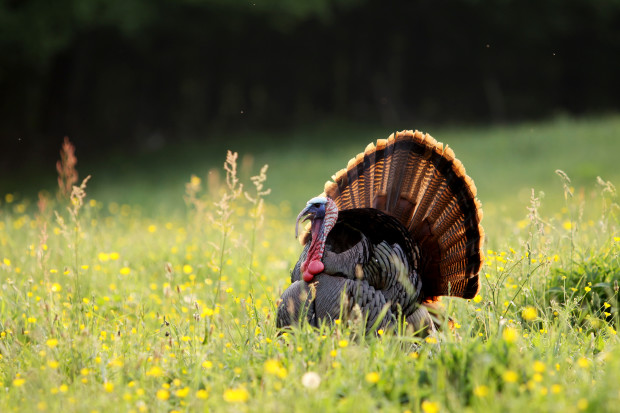We have much more to do and your continued support is needed now more than ever.
6 Tips for Feeding Wild Turkeys with Your Garden

Updated October 2021
The wild turkey is one of the most recognizable birds in all of North America and a symbol of the holiday season. As these fascinating and adaptable birds are becoming increasingly common backyard visitors and popular birdwatching subjects, you can turn your own yard or garden into a natural buffet to support them.
Instead of focusing on the turkey on your dinner plate, consider what food sources you can offer wild turkeys and increase your chances of seeing and enjoying them right outside your window. Here’s how to fill the wild turkey’s proverbial “plate” with food year-round.
Feeding Wild Turkeys the Natural Way

- Plant Native Oaks: Acorns are a key food source for wild turkeys. By planting native oaks, like red oak, chestnut oak and black oak, you’ll supply them with plenty of acorns to eat. Turkeys eat acorns in fall and winter and in many oak forests you can even notice a V-shaped scratching in the leaf litter (a sure sign of wild turkeys). Many other wildlife species rely on acorns as a food source, and oak trees are also important caterpillar host plants and nesting areas for birds, so you’ll be helping out more than just turkeys when you plant native oaks.
- Plant Other Nut and Berry-Producing Plants: In addition to oak acorns, other staples of the wild turkey diet include beech nuts, pecans, hickory nuts, crabapples, and hackberries. By planting native nut and berry-producing plants you’ll provide turkeys with the natural foods they’ve consumed for thousands of years. Other planting suggestions include black cherry trees, blueberries, wild grapes and dogwood. Wild turkeys consume cacti fruits in arid areas and like many species of wildlife, will even consume poison ivy berries too.
- Offer Seeds and Browse: Turkeys browse on plant buds and shoots in the early spring and feed off fern fronds, club mosses, and weeds such as burdock, especially when there is a lot of snow cover and other foods are hard to find. Grasses, sedges and many wildflowers provide wild turkeys with seeds to eat. We don’t encourage attracting turkeys with birdseed from feeders, mostly because artificially feeding turkeys causes them to lose their natural fear of people*.
- Grit and Gravel: Turkeys will swallow grit to help them digest their food. Offer grit by placing a shallow bowl filled with sand, fine gravel, sterlized ground eggshells or ground oyster shells. Or just keep a patch of sandy soil free of plants.
- Stop Using Pesticides: Aside from the direct harm you can cause wildlife by using pesticides, by not using these chemicals you’ll make sure that turkeys have plenty of much-needed protein in the form of insects. About ten percent of an adult wild turkey’s diet consists of small animals, including insects such as stink bugs, grasshoppers, and ground beetles, as well as snails, slugs, worms, spiders and other invertebrates. Turkey chicks, called poults, begin foraging shortly after hatching for invertebrates, which make up a large portion of their diet as they grow. Turkeys will actually help keep invertebrate pests in check for you, and there are many organic gardening techniques you can also use to control pest outbreaks.
- Leave the Leaves: By leaving some of autumn’s fallen leaves instead of throwing them all away, you’re providing habitat for the small animals that are a key part of a turkey’s diet. Turkeys forage for invertebrates in the leaf layer and also enjoy eating salamanders, frogs, snakes, and lizards that also live in the fallen leaves.
Bonus Tip: Provide a water source in addition to providing natural food sources. By providing a backyard pond or even a birdbath placed directly on the ground you’ll supply clean drinking water for the turkeys.
This year, learn more about turkeys than just the best recipes cook them. Discover the intriguing natural history of the wild turkey, make turkey-inspired crafts and laugh at amusing turkey trivia.

*Male wild turkeys are territorial and can occasionally become aggressive, especially during the spring breeding season. This often happens when wild turkeys are being artificially fed with feeders and have lost their natural fear of people, so avoid doing that. If turkeys are cleaning up spilled seed from songbird feeders, take those feeders down. If you have plenty of native plants in your yard, all the birds will have plenty of natural foods to eat.
If you encounter a turkey that’s got something to prove, assert your dominance by standing your ground and chasing it away by walking towards it with a broom or rake or spraying it with a garden hose to remind it where it fits in the pecking order. Male turkeys are large and intimidating and do have sharp spurs on their legs, but generally pose little actual threat of harm to humans. If you find that the wild turkeys in your yard are too much trouble, we recommend putting automatic sprinklers in your yard to scare them off whenever they show up. They also don’t like larger dogs and avoid yards where they are present.

Sign up for our free Garden for Wildlife newsletter. You’ll get great wildlife gardening tips and learn how to have your yard your garden recognized as Certified Wildlife Habitat.





















